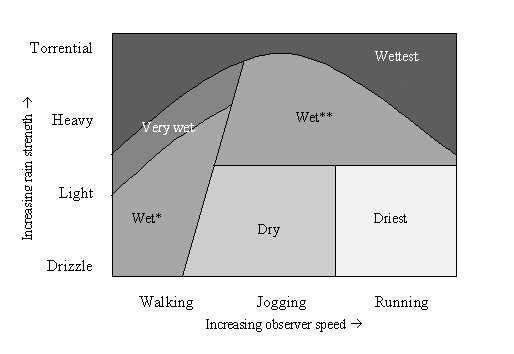|
|
Staying dry in the damp:
Should you run or walk in the rain?
By Dr. Jeffry Ruyter and Dr. Madelene Olano
Westin University, Pfingsten Road, Northbrook, Chicago, IL, 60062, USA.
Introduction
You're walking, it starts to rain, you have no umbrella and you have to go to work… here comes the eternal dilemma - do you keep walking briskly and get wet? Or do you run and get to work quicker, but risk getting wetter in the process? Here, in this important new paper, we analyse both so you don't have to make that agonising choice next time.
Methods
Our investigators wore light grey coats and light grey hats, both of which showed the rain clearly; these were weighed to obtain a dry weight. On reaching the destination, they were again weighed to obtain wet-weight, and thus calculate total rain wetness.
At the onset of rain, volunteers walked, jogged and ran the 1km to the destination, where they were re-weighed. Different degrees of rainfall were noted and measured, to see whether rainfall was typical of the average summer during the survey period, a method employed by Cook et al. (2004) in a similar study.
Rain is classified in a number of ways, but a combined MET office classification for rain is commonly used: Spitting, slight drizzle (up to 0.2mm per hour), moderate drizzle, thick drizzle, light rain (> 0.8mm per hour), moderate rain, heavy rain (> 30mm per hour), very heavy rain, torrential rain.
Results
The rain in Spain may fall mainly on the plain (Shaw 1964), but in this study, it fell mainly on those walking. All results are shown in Figure 1. Both walking in heavy/torrential rain, and running in torrential rain caused severe soakings. In light rain, jogging produced least overall soaking, and likewise for running in drizzle. Rain angle was not measured, but may have influenced the level of soaking. Hats became wetter than coats in lighter rain, but at faster speeds and in heavier conditions, coats collected more dampness.

Figure 1. Interaction of rainfall strength and observer speed
(* Hat wetter than coat, ** Coat wetter than hat)
Discussion
One volunteer took a taxi to the destination and remained 100% dry - a tactic noted for its success in this study, although not contributing much to its overall discussion. Another volunteer refused to leave the house, and also remained dry. Of those that did not cheat, jogging created the least overall dampness on arrival at the destination, and those clothes were dried very quickly (Roberts 2000). No wet weather conditions produced a glorious feeling (Kelly 1952).
Running in torrential rain was unproductive, as spray kicked up from shoes increased the water coverage on the coat. Walking in torrential rain was not recommended, as the coat quickly became waterlogged, further slowing the helpless victim. Jogging was therefore best, as it decreased exposure time, and had less spray from shoes. In light rain and drizzle, running was best for
dryness, as exposure time was reduced, while running in heavy rain, however, may decrease the life of the clothes, as tested by Robertson et al. (1946).
Rain and running angle influences which item of clothing gets wettest, and evidence (backed up by deMiranda & Cole 1996) suggests that if you wear a large waterproof hat, then walk slowly. Running in rain at night is another aspect that may require further study. Schnell et al. (2003) outlined details of road conditions in different weathers that should be taken into account during such exercises. However, the best advice may still be that of the MET office: Don’t go out unless your journey is essential, and if you still have to go out, take a brolly…
References
Cook, C., Reason, C.J.C. and Hewitson, B.C. (2004). Wet and dry spells within particularly wet and dry summers in the South African summer rainfall region. Climate Research 26, 17-31.
deMiranda, E.C. and Cole, R.S. (1996). Statistical analysis of angle of arrival in rain conditions on a 4.1km, 0.83mu m line of sight urban link. Electronics Letters 32, 476-477.
Kelly, G. (1952). Singin’ in the rain. MGM studios.
Roberts, J. (2000). ‘Drying clothes’. Antigonish Review 121, 52.
Robertson, R.M., Lobisser, R.J. and Stein, R.E. (1946). High speed rain abrasion of glass cloth laminates. Industrial and Engineering Chemistry 38, 590-591.
Schnell, T., Aktan, F. and Lee, Y.C. (2003). Nighttime visibility and retroreflectance of pavement markings in dry, wet, and rainy conditions. Transportation Research Record 1824, 144-155.
Shaw, G.B. (1916). Pygmalion. Penguin Books.





